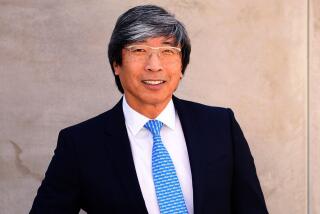Abraxis CEO, wife to give St. John’s $35 million
- Share via
A billionaire biopharmaceutical executive and his wife said Tuesday that they were giving St. John’s Health Center $35 million to complete its reconstruction and help put it on the frontier of biologically based research and treatment.
The gift from Patrick Soon-Shiong, founder and chief executive of Los Angeles-based Abraxis BioScience Inc., and his wife, Michele Chan, is the Santa Monica hospital’s largest individual donation ever and one of the largest received by a community hospital in California.
Much of it will fund the hospital’s expansion from 150 to 230 beds, one of the last steps in a replacement project that began after damage from the 1994 Northridge earthquake.
But $10 million will be used to map out the Chan Soon-Shiong Center for Translational Sciences, an example of growing interest in so-called translational medicine. Universities, drug companies and hospitals have in recent years sought to move more quickly from science to solutions. Such efforts meld or bridge research, development and treatment -- three enterprises that had traditionally been largely separate.
Soon-Shiong, a surgeon and researcher at UCLA before launching his drug development business, envisions the center as a world-class research hub that works closely with treating physicians to speed the translation of scientific breakthroughs from the lab bench to the patient’s bedside.
Soon-Shiong said he had long been troubled by what he called the “valley of death,” the lag time between a discovery and its practical application.
“This gap ... has really been a huge problem and has continued to plague our ability to address huge unmet needs -- cancer, multiple sclerosis, diabetes,” he said. Since school, “this has been a frustration of mine.... The discovery is made and decades pass before somebody has the courage to spend the money to validate it. So that’s why I thought this was clearly necessary to be developed.”
St. John’s CEO Lou Lazatin said the financial support and vision of Soon-Shiong would help set a standard for bringing cutting-edge medicine to patients.
“His leadership, his commitment, his brilliance will really transform us in how we practice medicine at this hospital,” Lazatin said.
“I think it will create the model for community hospitals in the future.”
Soon-Shiong said he wanted the translational center to bring together scientists with promising ideas and help them put their research to the test.
It would focus on the discovery and advancement of biologically based treatments and diagnostics, as well as techniques to predict an individual’s susceptibility to certain diseases.
In addition to hosting clinical trials, the center also would promote collaboration between the research scientists and treating physicians to efficiently apply what works to patients. The center would be open to researchers from nearby institutions, such as UCLA and Caltech, as well as from around the world and from a variety of disciplines, including biology, physics and mathematics.
“It’s a wonderful opportunity to be an assimilator of knowledge and a translator of next-generation knowledge right to the patient,” Soon-Shiong said.
Forbes magazine estimated Soon-Shiong’s worth last year at $3.4 billion.
His wealth is largely tied to his majority stake in Abraxis BioScience, the company formed last year through the merger of two companies that he controlled.
Soon-Shiong had a hand in developing the company’s first major drug, which is considered a potential blockbuster.
The drug, Abraxane, won federal approval in 2005 for the treatment of advanced breast cancer.
It causes fewer allergic reactions and appears to cause tumors to shrink more than paclitaxel, a first-line breast cancer treatment.
The company hopes it is similarly effective against other forms of cancer.
Soon-Shiong studied surgery at UCLA under David L. Morton, now chief of the melanoma program at John Wayne Cancer Institute at St. John’s.
“He’s one of my students who did very, very well,” Morton recalled in an interview last year. “He was a little bit ahead of his time.”
*







